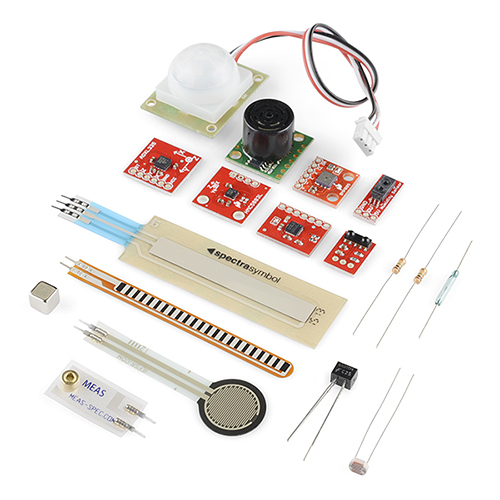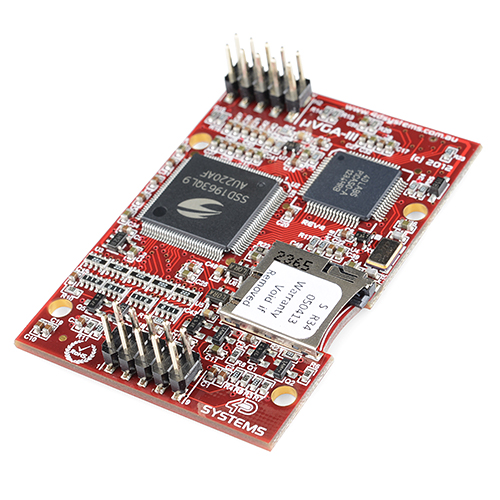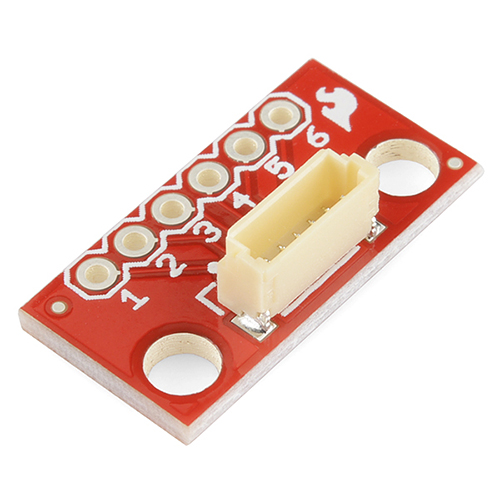We're back, and we have new products. There wasn't a whole lot to talk about with the products this week, so I decided to take the time and explain all the sensors that come in the sensor kit (seeing as we have a new version this week).
ReplaceMeOpen
ReplaceMeClose
Vimeo link here
Of course we sell all the sensors individually, so if there's something you think you can use, check the product page for the sensor kit. It has individual links for all the sensors, and you can buy them separately. We even have a wish-list compiled for everything that's in the kit as well.
We have a new version of the sensor kit this week. We realized (through feedback from customers) that many of the sensors need a 10K resistor. Also, the piezo needs a 1M ohm resistor, which isn't too common. So we've included a pack of 10Ks and a couple of the 1Ms. So now you don't need to add some extra resistors just to play around with the sensors.
The μVGA-III allows you to add VGA graphics (and processing) to your next project. You can use the 4D Systems' Workshop IDE to create software, and run it from the module. This new version has a new hardware layout and comes with the VGA connector desoldered.
More and more GPS modules are using the 6-pin JST SH connector. Instead of creating several breakout boards for each module, we just created a generic breakout board for the 6-pin cable. The GPS breakout has a vertical JST SH connector, two mounting holes, and six though-hole connections. This will work with modules like the D2523T, GS407, EM406, and EM401.
And lastly, we have a new version of the Tri-Color LED Breakout Kit. This simple kit lets you easily control three bright 10mm LEDs directly from your Arduino. We revised the layout of the board to be more betterer. We also have the new version in retail packaging.
That's all I have for this week. We'll be back again of course next week. As a reminder for anyone that's registered for AVC, if you haven't responded to my email about verification yet, you need to do so before Monday to compete next month! So check your email and get back to me ASAP so you can compete! See everyone next week!










I'm so glad you're not some stick-in-the-mud corporation that would refuse to say "more betterer".
We pride ourselves on poor grammar and made up words.Oh and RIDICULOUS abbreviations.
The linear accelerometer does not output a signal that tells you how fast you are traveling in three directions, it would be great if it did. I am sure you know this, and since you covered so much in the video I understand the oversimplification. People who are new to accelerometers might not know this, however. Three axis linear accelerometers tell you how much you are accelerating in three axes. If you were in a spaceship in microgravity with your rocket motor off, you would expect a zero signal on each axis. If the rocket thrust is aligned with the x axis, turning the rocket on will make the x axis signal change to some value which is proportional to the thrust of the rocket. As long as the rocket puts out a constant thrust, this new value will be maintained, but your speed (velocity) is not maintained, it is ever increasing. If you now shut off the rocket motor, the x axis signal will return to zero, but your speed (velocity) will be equal to the speed when you shut the rocket motor off. On earth, you also must account for the direction and magnitude of the force of gravity, since at rest we are experiencing 1g of acceleration due to the force of gravity. So, to determine your vehicle velocity, you have to "add up" or integrate the instantaneous accelerations along all three axes and also keep track of any rotations of these axes due to the vehicle turning. This is where the fun starts. There are also bias errors, noise, and gain errors which can change over temperature. The point is that determining vehicle velocity in three axes is a challenge, which can be done, but not with only a three axis linear accelerometer for most situations.
I there is a mistake: the photocell at 7:20 is a variable resistor, and doesn't generate a voltage unless you use external circuitry. The product page has it right.
I wished you guys used the Optical Detector/Phototransistor for your Weather Meters' Wind speed. I have had Reed Switch fail.
I think my eyes glazed over about 2 minutes in. What would be better than these videos than just quickly touching on the features of each board, would be a matrix of features and/or a decision tree.
What do you want to measure ? what interface do you want ?
table those two and it makes life a lot easier tryin to figure out what board you want.
For the first 3 (magnetometer, gyroscope, accelerometer) I get that, but the rest become increasingly a blurred distinction. They even give an example in the video for the box being open or closed - they used the flex sensor, but later on suggest using the LDR. Of course the latter wouldn't work if the surrounding is dark. On the other hand, you could just as easily use the reed switch. Or the ultrasonic rangefinder ( btw, this kit is missing a microphone. ) If you go a bit more abstract, then the answers actually become a lot more obvious; if you want to measure light, you're not going to get very far with either an accelerometer or a humidity sensor.
I do think it's a neat idea, but fleshing it out to something that's widely encompassing while not getting tangled up in itself may prove to be more challenging than anticipated.
The photocell is a variable resistor which changes its resistance based on the amount of light hitting it. It does not generate any voltage on its own.
"Different kites of day and night transitions..." :D
we fly kites at night mostly but are still in transition from the daytime style
Ohh an el wire lined kite would be an interesting project. Would have to use a 1aaa battery inverter, I'm guessing.
Sam
Does the soft pot stay in the position you leave it at or does it go back to some default value when you take your finger off of it?
It goes back to a default value - its construction is basically two conducting plates that are kept apart by some material, but pressing on the strip brings the two plates together. If you no longer press on it, the material pushes the plates apart again.